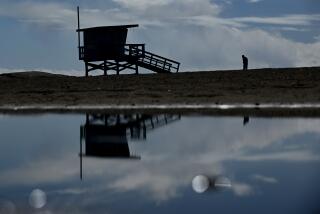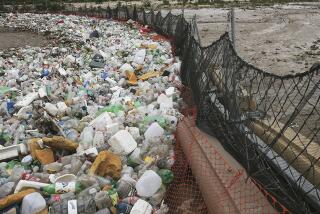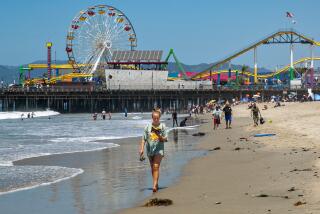Marina project seen as a threat to Baja estuary, wildlife
In a rocky, dun landscape dominated by saguaro and prickly pear, the estuary of the San Jose River is an oasis-like explosion of green.
Lined with tall reeds, the river — or at least some of it — flows year-round into the Pacific. Even those parts of the riverbed that are usually dry hold a life-giving treasure: Dig into the soil a few feet and you hit turquoise-colored groundwater. Two hundred species of birds call the wetland home.
But population growth in the Los Cabos region is placing the rich marsh under assault, environmentalists say. To build the newest big tourist project, a marina called Puerto Los Cabos, developers carved out a huge chunk of the estuary.
“This is the most important wetland on the southern half of Baja, and it’s the most important source of fresh water,” said Norma Sanchez of Angeles del Estero (Angels of the Estuary), an environmental group. “Why doesn’t anyone care to save it?”
Only a narrow berm of earth separates the newly built marina from the ocean; once the berm is removed, boats will be free to enter. Environmentalists are fighting to stop the project, which is to eventually include hotels and golf courses.
They argue that the excavation of the marina probably has already contaminated the area’s freshwater aquifer, a charge the developers dispute. The full project could further affect the wildlife habitat.
“They are planning hotels, beach clubs and condominiums,” Sanchez said. “These and other developments will completely surround the ecological reserve” established to protect the estuary, she added.
Representatives of the Mexican developers of the project, Grupo Questro, said they had complied with all environmental laws. A hydrological study recently commissioned by the company found that the estuary would not be contaminated by the marina project, spokesman Agustin de la Barra said. The water pressure from the freshwater aquifer is simply too great to allow ocean water to penetrate, De la Barra said.
The company website proclaims the marina “the area’s most ambitious development project in a generation.” The marina will accommodate 500 boats, “including luxury mega-yachts,” the website says.
The controversy over Puerto Los Cabos points to an eternal conundrum in this region: how to accommodate legions of tourists whose dollars are essential to the local economy without destroying the natural beauty that draws them.
“Our beaches are free of pollution, and that is a plus for our state,” said Marco Gonzalez, the representative in Baja California Sur state for Mexico’s federal Secretariat of the Environment and Natural Resources. “Unfortunately, all of this new development has proceeded very quickly.”
New hotels, spas, golf courses and condominium complexes dot the coastal highway between here and Cabo San Lucas, 20 miles to the southwest. The fast growth has left state and local officials far behind in their environmental planning, Gonzalez said.
Developers paid a fee of about $465,000 to ameliorate any environmental impact. Gonzalez said that if the project were found to be in violation of environmental regulations it could be halted and the builders forced to restore the area to its natural state. It remains unclear when the nearly complete marina might open.
Gonzalez said he did not think the outstanding issues were of “serious concern.”
Mexican environmental activists couldn’t disagree more.
In May, Greenpeace Mexico announced that San Jose del Cabo officials had received more than 10,000 letters from Mexico and abroad urging the city to protect the estuary and block the marina’s opening.
Greenpeace accuses the developers of violating a number of environmental laws.
In May, Greenpeace activists staged a sit-in outside Grupo Questro headquarters here.
The activists said the protest ended after the developers agreed to delay the marina’s opening until more studies were completed.
Sanchez, of Angeles del Estero, said environmentalists have yet to review Puerto Los Cabos’ latest hydrology report. But she believes much damage has already been done — and not just by the Grupo Questro project.
“Here in Mexico we treat our watershed as an afterthought, and not as an essential part of the ecosystem,” Sanchez said as she drove through the estuary, much of which is occupied by orchards, roads, and grasses as tall as two-story buildings.
She encountered new wells dug into the aquifer, including a large pond recently excavated with a backhoe that had filled with groundwater. An employee said the water was for a beachfront development project.
The city’s treated sewage flows into the wetland too. The treatment plant sometimes strains under the demands of the growing population. Last year, a breakdown at the plant sent a foul odor over the city for several days.
“It was so awful, people were leaving the area and checking out of their hotels,” Sanchez said.
It was a bitter reminder, she said, of how the tourist industry and the environment are linked.
hector.tobar@latimes.com
More to Read
Sign up for The Wild
We’ll help you find the best places to hike, bike and run, as well as the perfect silent spots for meditation and yoga.
You may occasionally receive promotional content from the Los Angeles Times.






